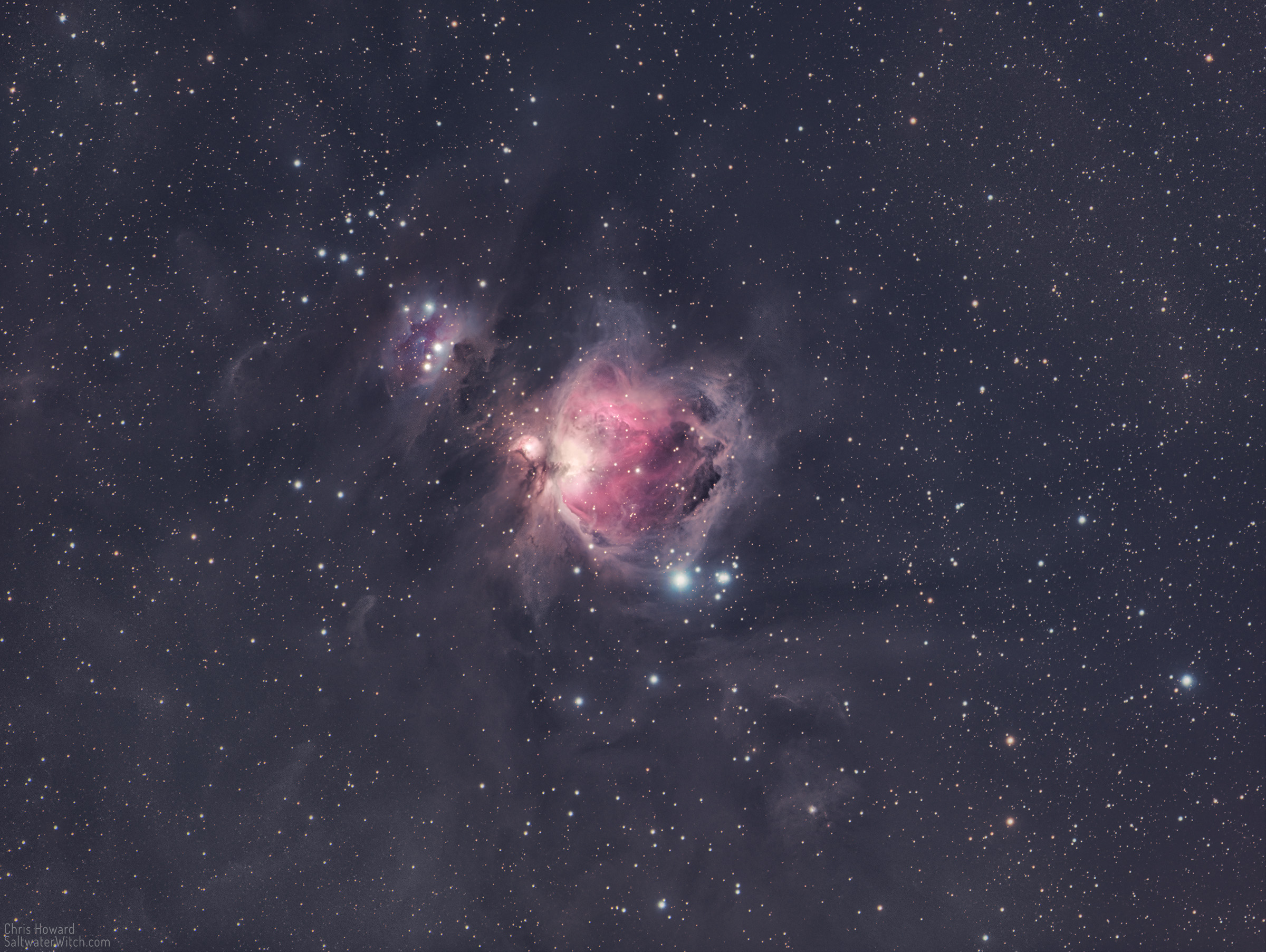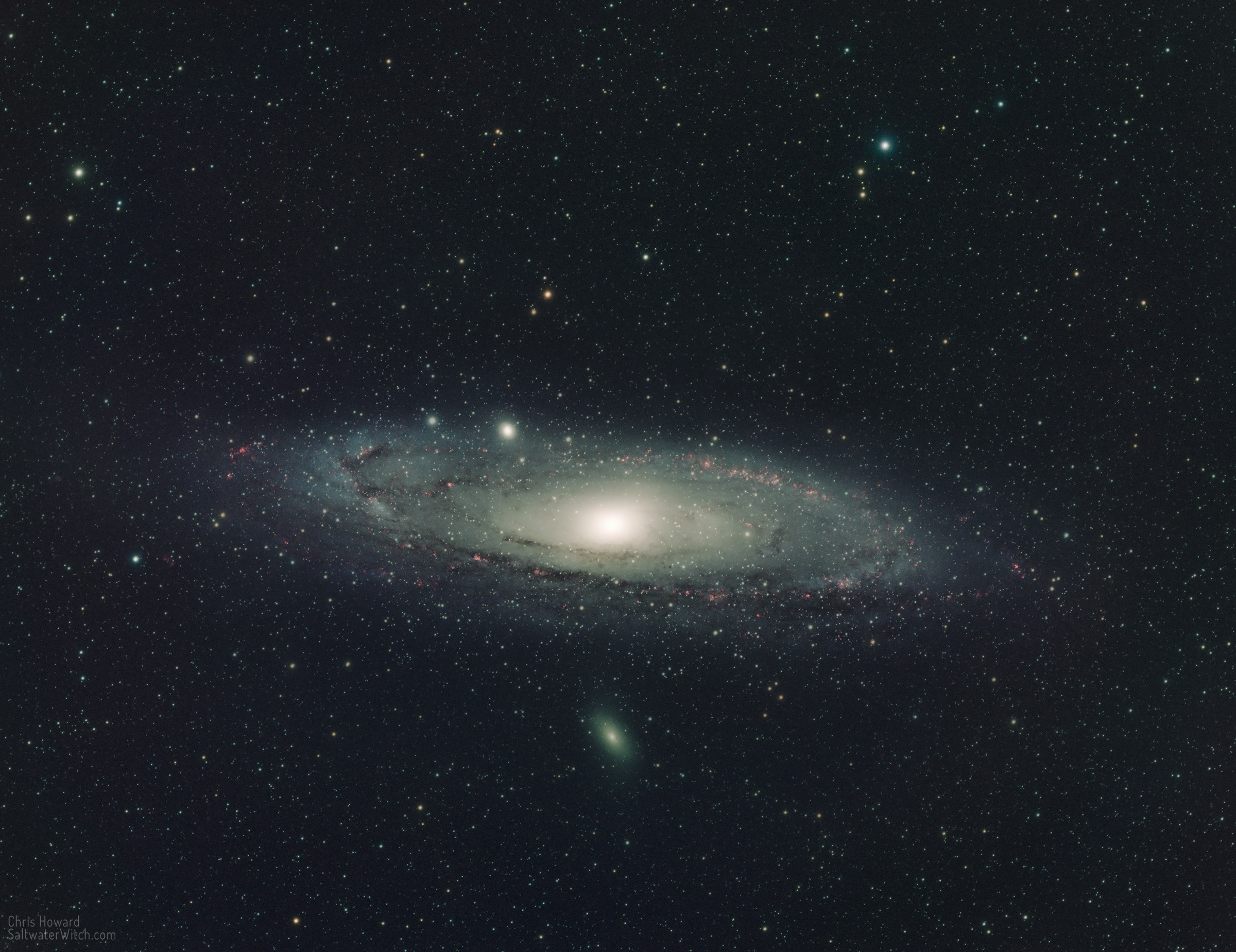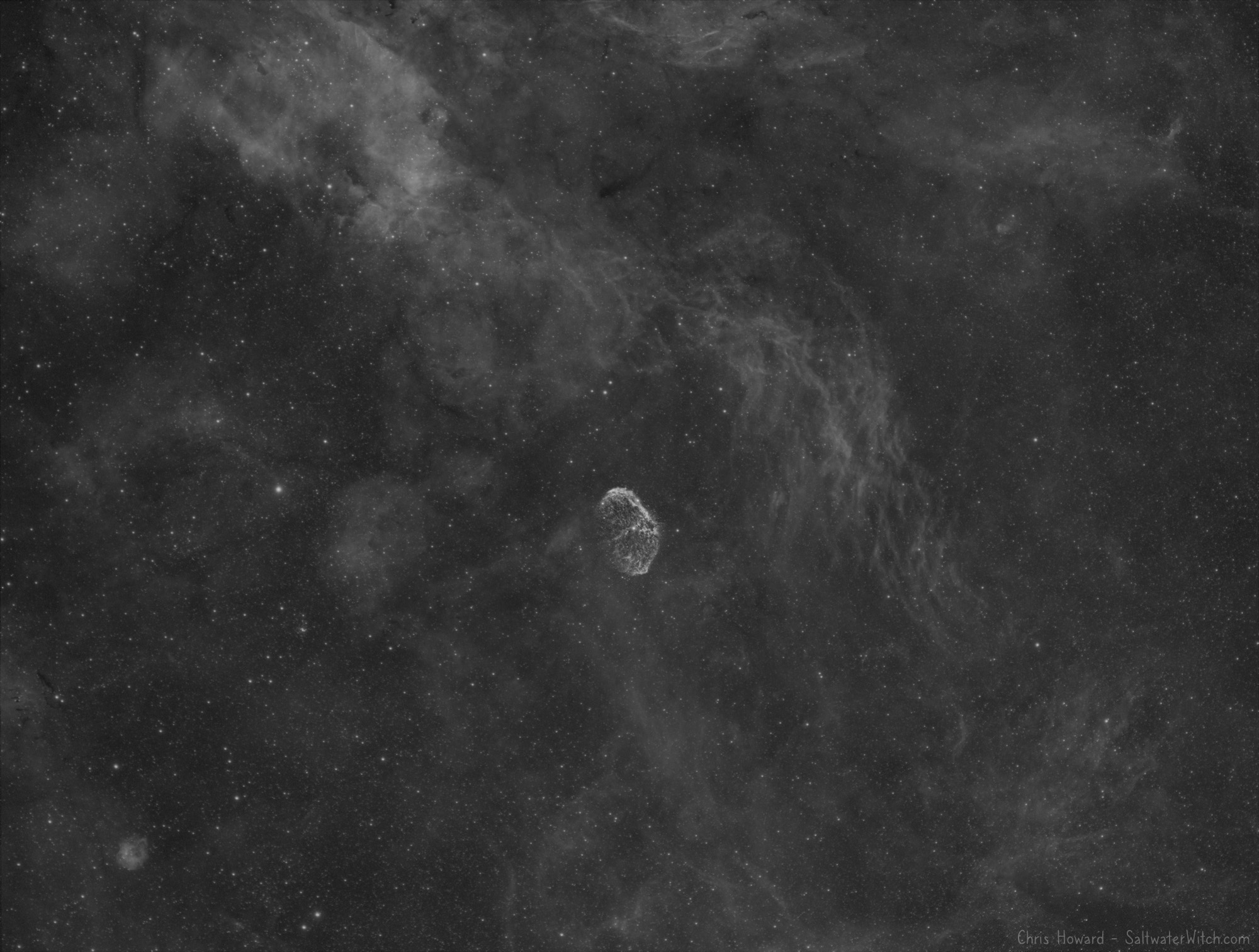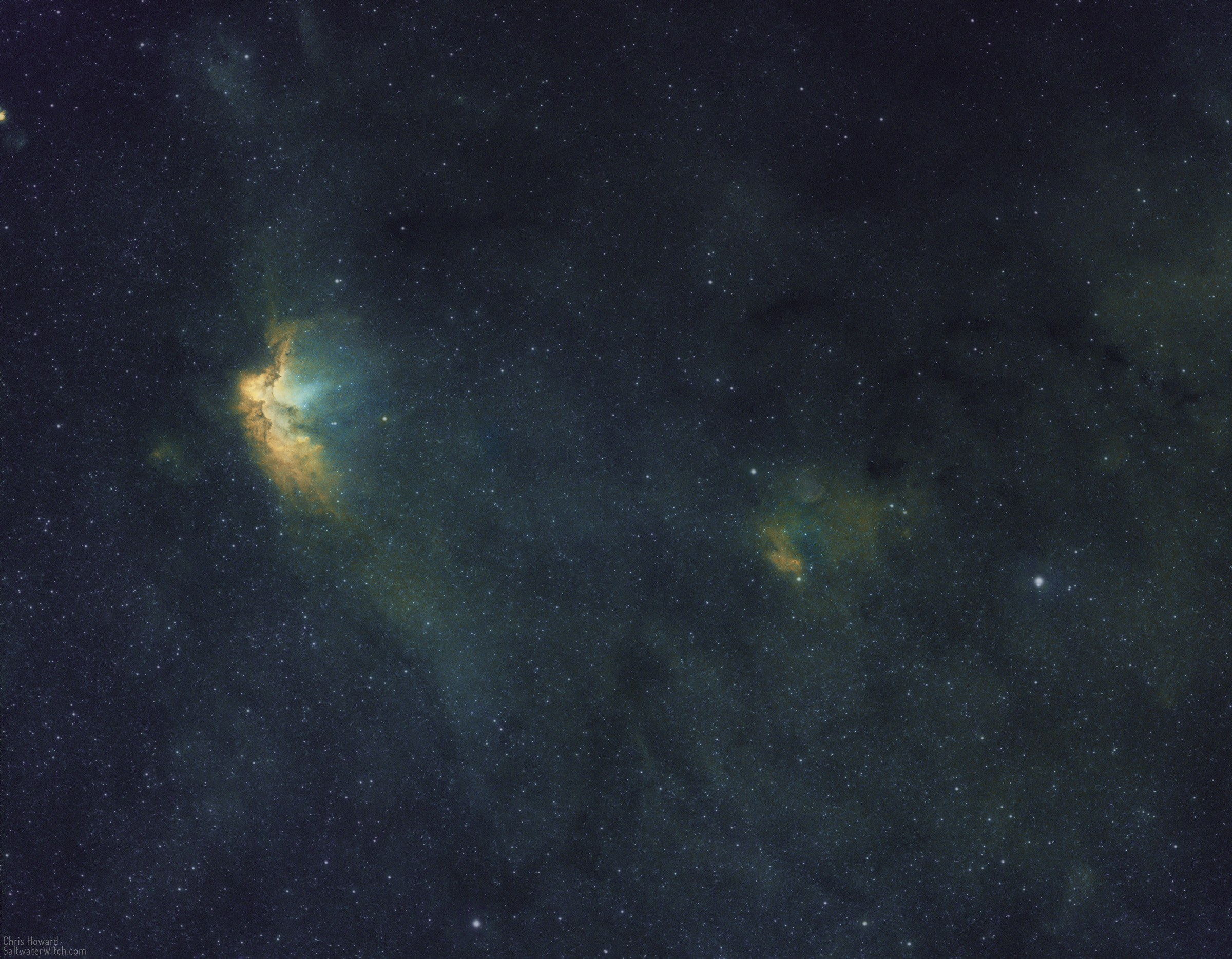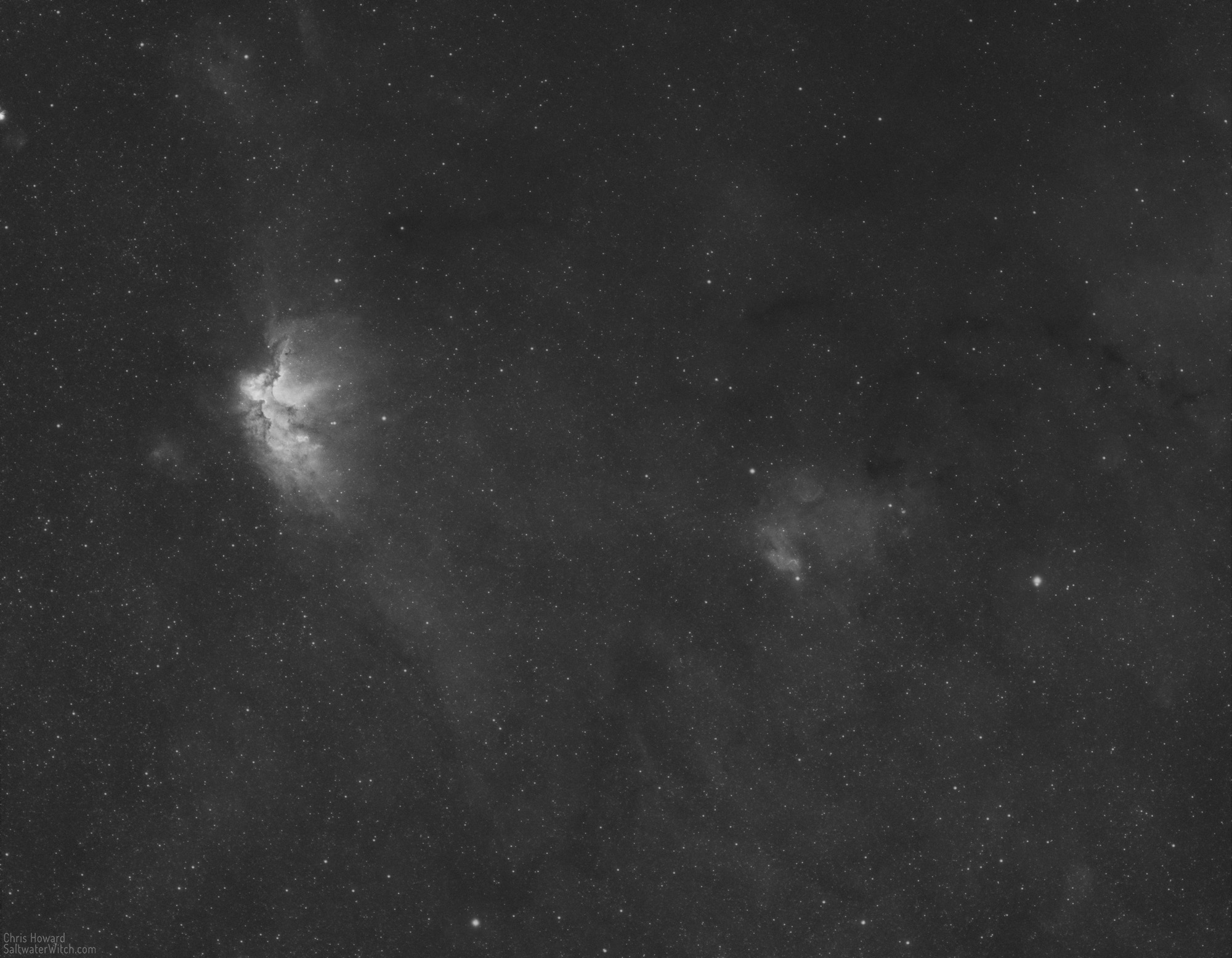The Elephant's Trunk in Ha
IC1396A, the Elephant's Trunk Nebula, is a twisted towering structure of interstellar gas and dust, back-lit and ionized by the intense radiation of the massive star just above it (HD 206267, HR 8281). The nebula's mix of organic and geometric shapes rimmed in light makes it stand out amid the eerie streams and swirls of dark nebulae and the backdrop clouds of ionized hydrogen that make up the expansive IC1396 HII region in the constellation Cepheus. The Elephant's Trunk is about 2,400 lightyears away and towers about 25 lightyears, or almost 150 trillion miles top to bottom (236 trillion kilometers). Imaging notes: 30 x 300-second subs in Ha, stacked in DSS. Apertura 800mm f/4 Newtonian OTA, ZWO ASI1600MM-Pro mono camera, Antlia 3nm Ha filter, ZWO ASI290M OAG, on the Sky-Watcher EQ6R-Pro mount with the ZWO ASIAir Plus controller.

Posted October 20, 2022
Narrowband with the Newt
We finally had some clear-ish skies last night after several days of gloom and rain, and I got to test out the 800mm f/4 newtonian scope with the ZWO ASI1600MM-Pro monochrome camera and 3nm narrowband filters. I spent most of the night imaging NGC 6888, the Crescent Nebula in Ha and OIII, and around 2am moved to the other side of the sky (away from a ~30% waning moon) to capture the Horsehead Nebula (B33) and the Flame Nebula (NGC 2024, Sh2-277), along with the leftmost star in Orion's Belt, Alnitak (bright star with the diffraction spikes from the Newtonian's secondary mirror) Alnitak is actually a triple star system, with most of the light and energy coming from ζ Orionis (zeta Ori), a massive blue super-giant 20 times larger than our star and over 21,000 times brighter. Imaging notes: 20 x 300-second subs in Ha, stacked in DSS. Apertura 800mm f/4 Newtonian OTA, ZWO ASI1600MM-Pro mono camera, Antlia 3nm Ha filter, ZWO ASI290M OAG, on the Sky-Watcher EQ6R-Pro mount with the ZWO ASIAir Plus controller.
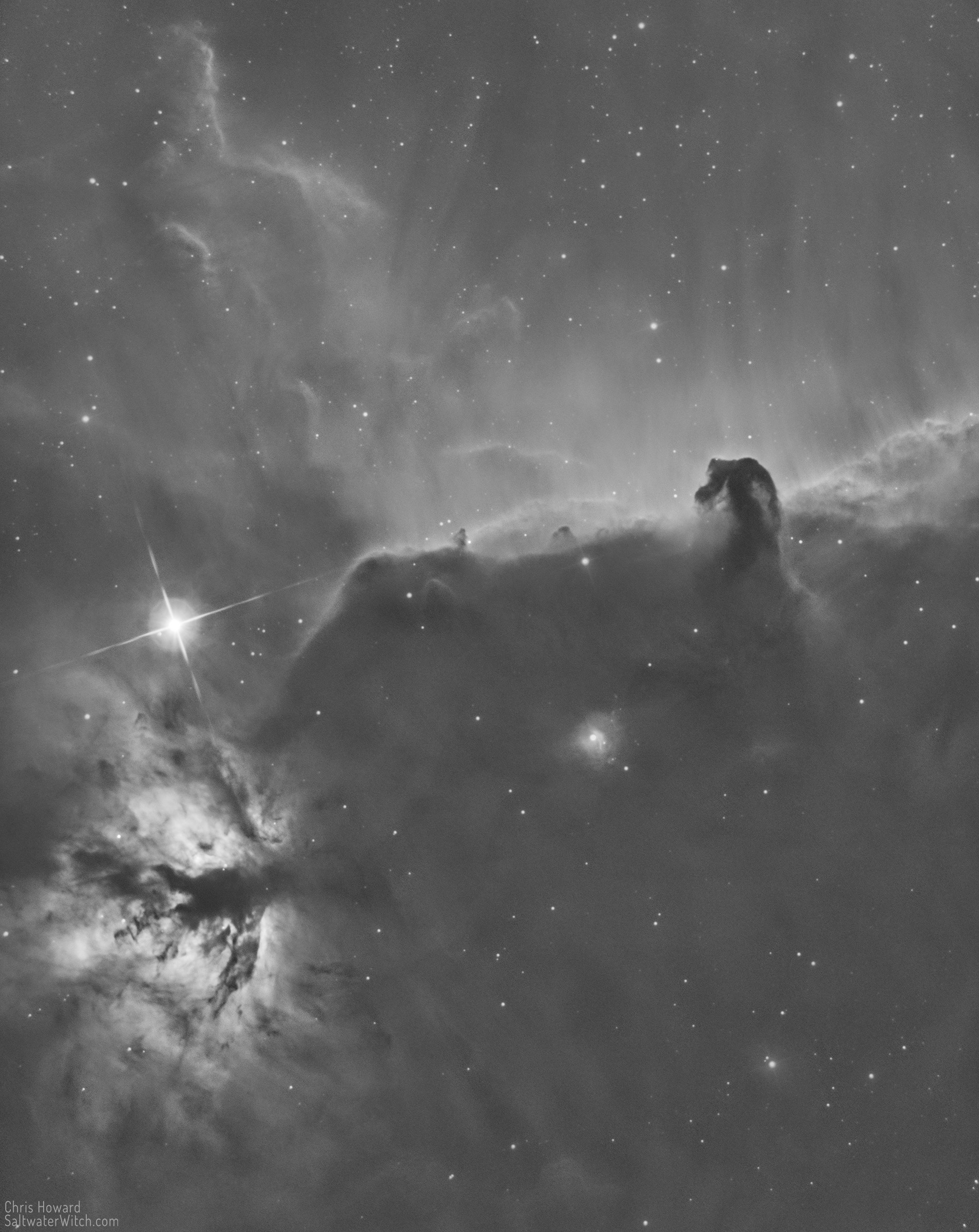
NGC 6888, the Crescent Nebula in Ha+OIII. The Crescent is an emission nebula 25 lightyears across, about 5000 lightyears away in the constellation Cygnus. This interesting set of structures with multiple shock waves, including an inner shell of hydrogen surrounded by an expanding envelope of oxygen (the semi-transparent bubbling blue structure) is the result of a collision of the fast-burning Wolf-Rayet star WR136 with a massive red-giant star. I usually shoot the Crescent in hydrogen-alpha only, and that will only pick up that inner crusty blob, but it's way creepier with the oxygen bandpass data and that weird semi-transparent blue sleeve, perfect for October. Imaging notes: 80 x 300-second subs in Ha and OIII, stacked in DSS. Apertura 800mm f/4 Newtonian OTA, ZWO ASI1600MM-Pro mono camera, Antlia 3nm Ha, OIII filters, ZWO ASI290M OAG, on the Sky-Watcher EQ6R-Pro mount with the ZWO ASIAir Plus controller.

Posted October 19, 2022
Orion Nebula in RGB
It's that time of year—my favorite, in fact. The autumnal equinox was on the 22nd, and that means Orion is back in the night sky, well actually in the very early morning sky. Last night the whole constellation was above the trees, around 25° rising in the East at 2 AM, and I captured 30 subs each for Red, Green, Blue, Luminance. Here they are stacked and processed.
Posted September 29, 2022
The Ghost of Cassiopeia
Gamma Cassiopeiae (γ Cassiopeiae) or just "Gamma Cas" and sometimes "Navi" is the center star in the "W" asterism that makes up the constellation Cassiopeia, one of the easiest constellations to find in northern hemisphere skies. It's an eruptive variable star—which sounds exciting for a star; this basically means it is unpredictably variable, with an apparent magnitude between 1.6 and 3, and does not follow an observed repeatable cycle. The two nebulae IC63 ("Ghost Nebula", below γ Cass in this rotation) and IC59 (above) are fairly dim, but do reflect light from γ Cass and other nearby stars, and IC63 exhibits some emission properties, gaining energy and then emitting it as light. Gamma Cas and both nebulae are about 550 lightyears away, very close to us. In terms of distance from Earth, this is one of the closest Deep Sky Objects I have ever captured, and M45, the Pleiades, at around 450 lightyears may actually be the closest. Imaging Notes: 93 x 180-second subs across Red, Green, Blue filters (Astronomik Deep Sky RGB), ZWO ASI1600MM-Pro monochrome camera running at -10C, ZWO AM5 EQ mount, William Optics SpaceCat 51 apochromatic refractor, ZWO ASI290MM guide camera with OAG.
Posted September 29, 2022
Cocoon Nebula and Barnard 168
The Cocoon Nebula (IC 5146, Caldwell 19, Sh2-125) is a combination reflection and emission nebula in Cygnus, and the long trail of dust is the dark nebula Barnard 168. (In an emission nebula, the intense radiation from one or more stars causes the surrounding gases—hydrogen, oxygen and other gases, to release energy and emit their own light, e.g., the hydrogen itself is lit up. In a reflection nebula, the light from one or more stars reflects off or shines through the surrounding interstellar dust, hydrogen, and other gases. So, there's a bit of both going on in the Cocoon). The last time I captured the Cocoon Nebula, a little over a year ago, I used the 800mm Newt and IC 5146 (the circular red region) filled most the whole center part of the image. This time, with the SpaceCat's wider field of view, 250mm focal length, I framed the area to be able to capture the long stream of interstellar dust catalogued as B 168. The Cocoon, IC 5146 is about 4000 lightyears away, and the central star illuminating the surrounding gas and dust is a newly-formed star, maybe only 100,000 years old (compare to our star: the Sun is around 4.6 billion years old). Imaging Notes: 90 x 180-second Red, Green, Blue filters (Astronomik Deep Sky RGB), ZWO ASI1600MM-Pro monochrome camera running at -10C, ZWO AM5 EQ mount, William Optics SpaceCat 51 apochromatic refractor, ZWO ASI290MM guide camera with OAG.
Posted September 29, 2022
M31 in HaRGB
Beautiful skies last night, mostly clear, and no moon, the perfect night for broadband color with separate RGB filters, and I went after one of the finest northern hemisphere color targets. Andromeda (M31) is one of our galactic neighbors at only 2.5 million lightyears away. Our own galaxy, the Milky Way, may have as many as 400 billion suns, while Andromeda may have as many as a trillion suns. M31 is about 152,000 light-years across, and the Milky way is a bit under 90,000 lightyears. We're both good-sized barred spiral galaxies. Stick around for a few billion years and you can watch us collide and form one massive galaxy. Notes: 51 x 120-sec Red, 53 x 120-sec Green, and 56 x 120-second Blue filter (Astronomik Deep Sky RGB filters), 60 x 180-second Hydrogen-alpha (Astronomik 6nm), ZWO ASI1600MM-Pro monochrome camera running at -10C, ZWO AM5 EQ mount, William Optics SpaceCat 51 apochromatic refractor.
The Milky Way and Andromeda are two of the largest members of the Local Group, which contains about 80 galaxies, most of which are dwarf galaxies with something like 10 billion stars or fewer. M110 (below) and M32 (above) are satellite galaxies of Andromeda, and both are dwarf galaxies in the Local Group. Most of these dwarf galaxies don't have much of an internal structure, no dust lanes, very little star formation. (M110 is an exception, in that there are remnants of a spiral of interstellar dust and there's ongoing research looking at M110's origins and development). Andromeda may contain a trillion solar masses and the Milky Way galaxy contains around 400 billion solar masses—give or take a few billion. From our perspective along the Orion-Cygnus Arm (sometimes called the "Local Arm") of the Milky Way, the Andromeda Galaxy is at an angle, tipping toward us, inclined around 77° relative to Earth. I believe the edge of M31 with M110 (bottom in this rotation) is the side closest to us. One of the notable catalogued regions within the galaxy is NGC 206 (bright bar on the lower left side), a star forming region with hundreds of relatively new spectral class O and B stars. These hot blue-giant stars are so bright and massive we can resolve them from our galaxy with consumer telescopes.
Posted September 25, 2022
The Crescent
NGC 6888, the Crescent Nebula in Cygnus, is mostly made up of ionized hydrogen with a filmy envelope of oxygen (not present in this Ha-only data). Its longest side spans about 25 lightyears, or about 235 trillion kilometers (146 trillion miles), which at only 5000 lightyears away, is a pretty good-sized deep sky object. I spent the entire night capturing hydrogen-alpha data, over 60 subs, 53 of which I used in this stack. I will come back on another night to capture the OIII data. Notes: William Optics SpaceCat51 apochromatic refractor, ZWO ASI1600MM-Pro monochrome camera cooled to -10C, 53 x 300-second subframes (about 4.5 hours of data) stacked in DSS, ZWO AM5 EQ mount, ASIAir Plus controller. (I ordered the ASIAir early August—backordered, and it arrived a couple weeks ago. This is only my second time out with the Air, and I can already see this being be my away-from-home controller).
Cropped to focus on NGC 6888 (above), here's the full FoV from the SpaceCat and ASI1600:
Posted September 17, 2022
Off to shoot the Wizard
NGC 7380 is an open star cluster in Cepheus, surrounded by the bright emission nebula Sharpless 142 (Sh2-142, center, left), but we all know it as the Wizard Nebula. Why? Well, because it sort of looks like a bent old dude with a pointy hat looking out over a vast expanse of nebulosity, loops of dark interstellar dust, and a spread of hot stars bathing everything in intense radiation, all of which could be mistaken for some sort of magical display. In other words, what a wizard might do. That's my guess, anyway.
Last night was also my first night out with the ZWO ASIAir Plus (astro device controller), and because the Wizard has all three bands present to some degree, hydrogen-alpha, oxygen 3, and sulfur 2, I thought I would try something new: shooting 10 subs for each filter, running autofocus for each set, and then looping through each set of three filters three times. This way I would end up with 30 sub frames for each over the course of one night, a reasonable amount of data. This would also allow me to see how the meridian flip went, how well the autofocus routines work, and more. Note: with the 3nm Antlia Pro narrowband filters, each autofocus run takes about 7 minutes, with a set of 20 second exposures—the routine needs at least 20 just get enough stars to focus with these very narrow 3 nanometer filters.
It was also a cool mid-September night and with wind gusts and "poor seeing" according to the Clear Sky Chart, the guiding with the ZWO AM5 wasn't outstanding, but good enough for 300-second exposures, never straying too far above an arcsecond.
Here's the combined narrowband result in SHO, the Hubble Palette, where Sulfur is mapped to Red, Hydrogen to Green, and Oxygen to Blue in RGB colorspace.
Here's the Hydrogen-alpha data by itself:
